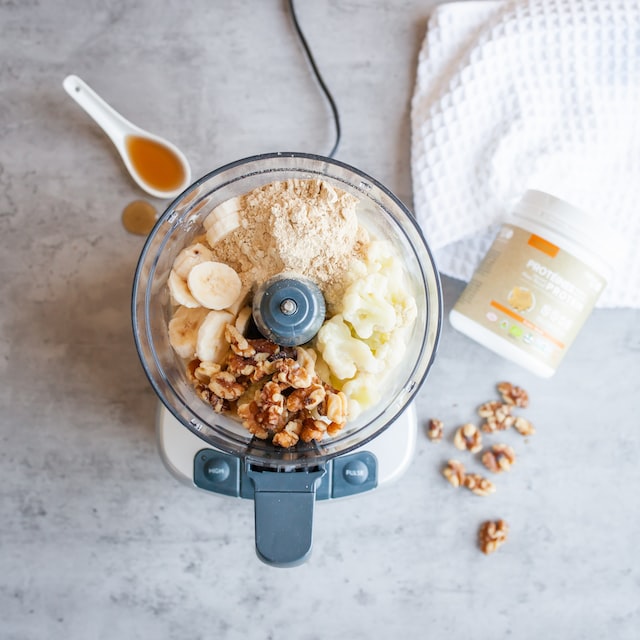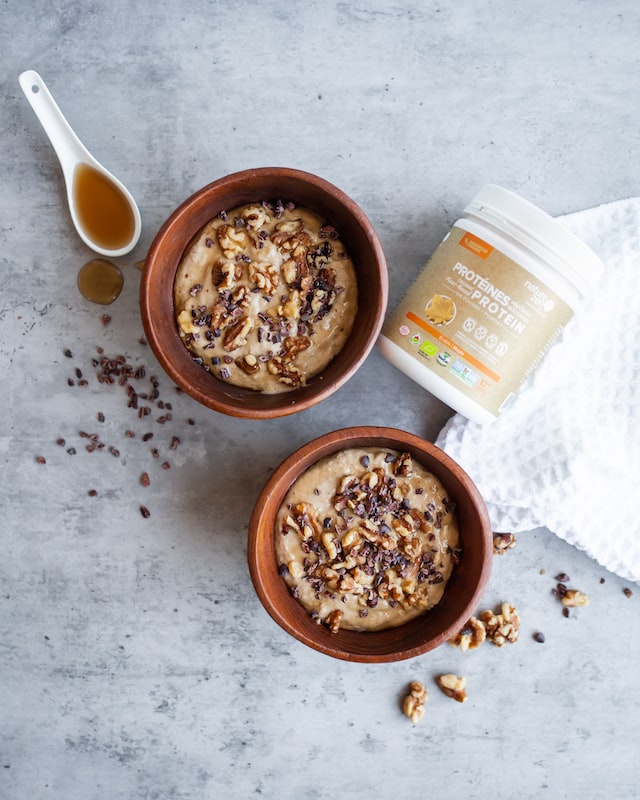Whether you have breakfast on the move or can sit down and enjoy a meal before the day begins, having protein in your morning meal has a number of advantages. Aside from the fact that, when combined with high fiber carbohydrates and fat, a protein-rich meal can fight off hunger for longer and give you more stable blood sugar, it also helps with various important body functions, such as cell repair and maintenance.

Protein is used by your body to construct all tissues, including hair, skin, muscles, organs, and hemoglobin in your blood. A diet packed with protein, as well as high fiber carbs and fats, offers numerous advantages, including increased energy and blood sugar stability. Adequate protein consumption also aids in the preservation of muscle mass.
Keep on reading for more about the benefits of having increased protein in your breakfast, discover fantastic protein sources and see recipes to try.
Protein Fundamentals
Protein, along with carbohydrates and lipids, is one of three macronutrients. There are several suggestions for how much protein you should consume. Protein should account for 10% to 35% of total calories, according to some estimates, while others propose 1.2 to 1.7 grams per kilogram of body weight per day for more active people.
Further research on muscle building reveals that a minimum of 1.6 grams per kilogram of body weight each day, divided across four meals, is optimum, with a maximum limit of 2.2 grams per kilogram of body weight.
According to current USDA dietary standards, protein should account for 10% to 30% of total calories consumed. Endurance athletes and others attempting to gain or maintain muscle mass may require more. Furthermore, protein requirements vary with aging.

Protein consists of amino acids, of which nine are deemed essential, which means your body cannot produce them and must receive them from food. Animal protein has all of the required amino acids, whereas plant protein does not always. If you strictly follow a vegetarian or vegan diet, you will need to organize your protein sources so that you get enough of the important amino acids.
The Advantages of a High Protein Breakfast
A meal high in protein has various advantages over a breakfast high in carbohydrates, such as a bagel or toast. Protein helps you feel fuller for longer, so you can get through that morning meeting. It also helps to maintain blood sugar levels steady when paired with carbohydrates and fat.
If you regularly skip breakfast or only eat a slice of bread, eating a balanced breakfast with protein will help keep your energy levels stable.
Consuming an adequate amount of protein becomes more difficult if you do not eat much at breakfast. However, obtaining a good portion of protein in the morning will increase your chances of receiving enough throughout the day.
According to the American Society for Nutrition, most Americans consume the most of their protein at supper and the least at morning. Instead, spread out your protein consumption more equally throughout the day, with similar amounts at each meal.

With a more even protein split, you may have higher meal pleasure throughout the day, as well as more consistent energy levels. Other study on maximizing muscle growth backs up this idea.
According to research on protein at breakfast, having 35 grams of protein resulted in lower hunger hormones and higher meal satiety hormones than consuming only 13 grams of protein.
Breakfast Foods with a High Protein Content
A protein-rich breakfast can take various forms. Although most people think of meat when they think of protein, there are many other foods that contain protein, whether you prefer savory, sweet, or plant-based breakfasts.
While protein is frequently highlighted, it is also critical to ingest the other macronutrients, carbohydrates and fats, at breakfast for balanced nutrition and long-lasting energy. Carbohydrates provide satisfying fiber and are your body’s primary fuel source, whereas fats aid in micronutrient absorption, decrease digestion for increased meal satisfaction, and improve the taste of your foods.
Remember to include a variety of fruits and vegetables in your breakfast to improve nutritional quality and ensure you get enough vitamins, minerals, and antioxidants.
Breakfast Meats Packed with Protein
Meat is a very efficient way to pack in protein in the morning for individuals who enjoy a full, savory breakfast. Breakfast typically includes a variety of high protein meat-based dishes, so you have some options. If you’re watching your sodium intake, you should be aware that breakfast meats frequently have high salt levels.
Breakfast Meat Alternatives
- Breakfast sausage (lean): Each serving contains 18 grams of protein.
- Ham: 14 grams per 3-ounce serving.
- Turkey bacon (2 Slices): contains 4.8 grams of protein.

High protein content Eggs and dairy
Dairy and eggs are both high-quality protein sources that are popular breakfast items. Dairy also has calcium, vitamin D, and magnesium, all of these being important for bone health. Fermented dairy products also include gut-loving probiotics, which can help improve gut microbial balance.
Eggs are also abundant in nutrients and include highly accessible protein that is easily absorbed and utilized throughout the body. They also go well with whole-grain toast, protein sources from meat, healthy fats like avocado, and vegetables like pepper, spinach, and mushrooms. Yogurt and cottage cheese, on the other hand, go nicely with meals like nuts, apples, berries, and melons.
Cottage cheese, seasoned with pepper, paprika, and cucumber slices, can also be served as a savory option. It’s also delicious nestled into eggs, mixed into high-fiber porridge, or topped with avocado toast.
Dairy Choices
- Skyr has 17 grams of protein every 150-gram meal.
- Greek yogurt contains 16 grams of protein per 5.5-ounce cup.
- Cottage cheese has 11 g of protein per 4-ounce serving.
- Regular yogurt has 8.5 grams of protein per cup of
- Eggs provide 6 grams of protein per egg
Grains with a High Protein Content
While grains do not provide as much protein per serving as meat, dairy, or eggs, they can nonetheless carry a protein punch. Combining high-protein grains with other protein-rich meals is a good strategy to increase your diet’s diversity, fiber, and minerals.
If you don’t eat animal protein, it’s important to eat a range of protein-containing grains, beans, and legumes to ensure you get all of the amino acids you need. Remember that plant protein sources often do not include all of the key amino acids your body requires.
These grains can be ground into flour and baked into pancakes, waffles, muffins, or bread, or they can be eaten whole or gently processed and cooked like morning cereal. Quinoa, for example, can be served in the same way as oatmeal for a higher protein version of your favorite breakfast.
To prepare high-protein granola, toast grains and nuts together. For a balanced breakfast, serve this on top of Greek yogurt with fruit.

Grain Choices
- Amaranth contains 9 grams of protein per cup.
- Quinoa has 8 grams of protein in each cup.
- Oatmeal has 6 grams of protein per cup.
- A quarter cup of spelt contains 5 grams of protein
Other Protein-Rich Breakfast Options
Breakfast does not have to be boring. If you enjoy eating leftovers for morning, the previous night’s supper can provide a balanced breakfast choice. There are also unique ways to serve higher protein dishes with sources of carbohydrates and lipids to increase protein content while changing up your typical breakfast.
Tofu can be scrambled similarly to eggs for a plant-based high protein dish and served with a whole grain bagel or toast for lunch or dinner. Some individuals like to make a breakfast burrito with leftover steak, cooked ground meat, or chicken breast wrapped in tortillas. To add protein to oatmeal, whisk in egg whites or yogurt.
Protein powders, such as whey or plant-based alternatives, can add a handy protein boost to any meal. Mix protein powder into foods that don’t naturally contain as much protein, such oatmeal or a fruit smoothie.
A Final Thought From DigEnet
Including protein in your morning meal, coupled with high fiber carbs and fat, will provide various benefits, including longer hunger control, more stable blood sugar, and more steady energy levels.
There are numerous methods to get protein for breakfast, whether you prefer savory or sweet. If you follow a plant-based diet, experiment with different protein sources to ensure you get all of the required amino acids.
